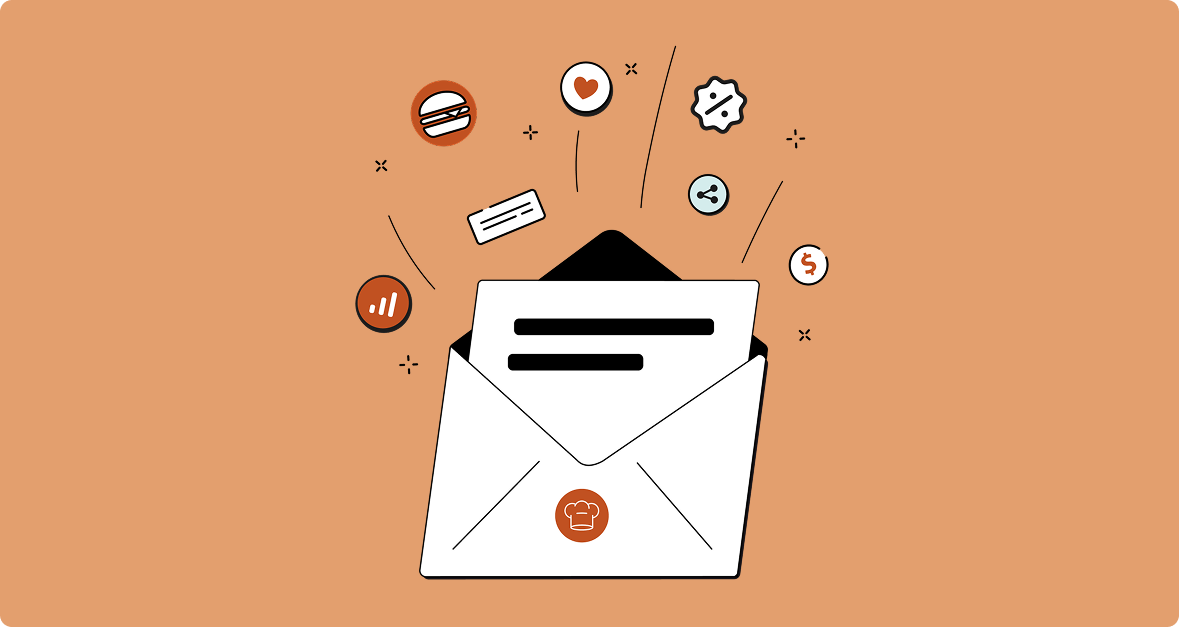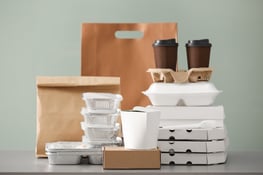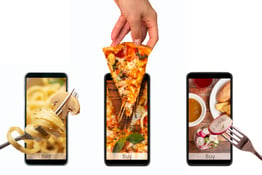We live in an increasingly on-demand world. Your customers expect fast, easy, and convenient delivery. This explains the massive growth of third-party delivery apps.
According to Statista, the U.S. online food delivery sector will top $430 billion in revenue in 2025, and top $600 billion by 2030. Restaurant delivery apps like DoorDash, Grubhub, Uber Eats, and in Canada, Skip the Dishes, are helping to drive this growth by providing user-friendly, contactless ordering and delivery experiences. And as they grow in popularity, these sophisticated apps are also reshaping customer expectations.
But how are these third-party delivery apps reshaping the landscape for restaurants? What are the benefits of enlisting these external restaurant delivery apps? Are there drawbacks for your business? And is using them worth it?
We checked in with our resident Back of House restaurant tech expert Spencer Michiel to learn more.
What Are Third-Party Delivery Apps and How Do They Work?
Broadly speaking, third-party delivery apps are mobile apps that your customers can use to place delivery orders. These restaurant delivery apps typically handle every part of the process, including:
- Displaying your digital menu
- Receiving delivery orders
- Processing payments
- Dispatching drivers
- Providing delivery status updates
Integrating Third-Party Delivery Apps With Existing Systems
In order to complete these tasks, the leading third-party delivery apps must be able to integrate with leading POS (point of sale) systems like Toast, SpotOn, and Otter. The top delivery apps will also integrate with your online assets.
For example, industry-leading delivery app DoorDash provides total integration with your website, as well as social media platforms, Google search, and online maps. This means that your customers should be able to access the delivery app for placing orders from any one of these platforms.
The Pros and Cons of Third-Party Delivery Apps
Restaurant delivery apps sound pretty great, right? Well, they can be. But Spencer acknowledges that “it’s a very opinionated space.” That’s because third-party delivery apps can expand your reach, visibility, and delivery volume, but they may also charge high commission fees.
“Restaurant owners will rail on third-party delivery apps for their commissions,” says Spencer. “But I think there's a disconnect sometimes in exactly what these apps are and what they do.”
So let’s clear the air with a closer look at the pros and cons of using third-party delivery apps.
The Pros of Using Third-Party Delivery Apps
Restaurant delivery apps offer a number of advantages:
Larger Customer Base
Leveraging third-party delivery apps can increase your visibility and help you attract new customers. When you partner with a third-party delivery app, you gain access to all the users on that delivery app. This can result in a dramatic uptick in exposure.
For instance, Grubhub has more than 31.5 million active users; DoorDash claims more than 42 million active users; and Uber Eats provides exposure to a massive network of 95+ million users.
Spencer says that, quite simply, “The marketplace and the exposure you get — you're not going to find that anywhere else.”
Outsourced Delivery Work
Third-party delivery apps can be especially helpful to restaurants that struggle to hire and retain workers. Many of the leading restaurant delivery apps provide their own drivers and handle every aspect of delivery driving. Naturally, this means you don’t have to spend the time or money to hire and employ delivery drivers.
But the benefits go beyond that. When you outsource delivery work, you also relieve yourself of a ton of added costs and headaches. With third-party delivery apps, you don’t have to worry about insuring drivers, handling tip distribution, paying gas reimbursements, or managing the risk and liability that come with driver delivery.
Meeting Evolving Customer Expectations
Third-party delivery apps are popular for a reason. They make the process of ordering, paying for, and receiving food fast, frictionless, and hassle-free for your customers. Diners have developed a taste for speed and convenience.
For many fast-casual and quick-service restaurants (QSR), using third-party delivery apps may be the only way to keep up with these expectations. According to the 2025 DoorDash Delivery Trends Report, 46% of consumers surveyed prefer to order using third-party delivery apps. Among the top reasons they prefer to order through apps are ease of use (49%), convenience (42%), and familiarity (22%).


Subscribe to Our Monthly Operations Newsletter
Learn how to streamline your processes, cut costs, and run a more efficient restaurant.
The report also shows that these preferences are especially strong among younger consumers. For example, while consumers on average order food using third-party delivery apps 4.6 times per month, Gen Z consumers tend to order on restaurant delivery apps 5.1 times per month. This suggests that restaurants can expect demands for speed and convenience to increase in the future.
The Cons of Using Third-Party Delivery Apps
Despite the benefits of using third-party delivery apps, there are a few potential drawbacks you should be aware of as well.
Commission-Based Fee Structure
Many of the leading third-party apps use a commission-based fee structure. The size of that fee can vary depending on the provider you use. But in many cases, that fee can be high enough to really cut into your profit margins on deliveries. Nation’s Restaurant News (NRN) points out that delivery app fees typically fall between 15-30% on every order.
For national chains and large restaurants with brand recognition, this cost may be a no-brainer in exchange for the reduced labor costs and the uptick in visibility and reach. “The math definitely works out for the big guys,” says Spencer.
But the equation can be a little different for independent restaurants. NRN notes that restaurants with larger sales volumes may be able to negotiate commission fees. Small and independent restaurants may not do enough delivery volume to negotiate this cost. Make sure you do the math as you decide whether certain third-party apps are worth it for your restaurant.
Reduced Cash Flow
One of the frequently overlooked challenges when working with third-party delivery apps is that you have to wait longer to get paid. When you process credit cards for traditional in-house delivery, you may have to wait a day or two to see transactions in your restaurant’s account.
Third-party apps may work a bit differently. In most cases, the delivery provider will receive payment and collect their commission before distributing payments to you. You could wait as long as a week for payments, depending on your provider.
This can cause added stress for small operations with limited cash flow, so it's something you need to be aware of as you consider potential delivery app providers.
Reduced Access to Data
Your restaurant’s data is incredibly valuable. Third-party delivery apps know this, and that’s why they keep it to themselves.
Spencer explains, “DoorDash and Uber Eats know a ton about the spending habits of their customers. They know all the patterns. They've got teams looking at segmentation, looking at what customers are buying…but they don't share any of that with the restaurants.”
This differs from some of the first-party delivery apps like ChowNow. With first-party delivery apps, your in-house people still do all the driving and delivery, but the vendor provides exposure, manages your orders, and integrates with your POS. In exchange for doing more of the delivery legwork, you get access to all of your customer data (and a commission-free payment structure).
Diminished Quality Control
You may not have to pay for a team of delivery drivers when you use third-party delivery apps. But you also don’t have much control over how the drivers treat your food or your customers. When you deliver food using an outside service, the customer experience depends on delivery drivers who don’t represent your brand and are almost certainly unaware of your restaurant’s values.
This doesn’t mean your third-party delivery driver won’t do a good job. It just means that you have little ability to control this outcome. This is why it’s really important to choose third-party delivery apps that offer a strong service guarantee, excellent customer support, and a reputation for hiring good drivers.
Is It Worth It?
Of course, that’s the million dollar question. Are third-party delivery apps worth it?
Absolutely, says Spencer.
He acknowledges that the big third-party providers do charge high commission fees. But he says the numbers still work out pretty well for most restaurants. Even after you factor in the cost of commissions, using a third-party delivery service “is still cheaper than paying a delivery driver and paying to be on another type of marketplace that has more than 95 million users,” he says.
How to Offset the Cost of Commissions For Third-Party Delivery Apps
Spencer also offers a few helpful suggestions to restaurants who are concerned about the cost of commissions. For one thing, he suggests, “you could raise your prices to cover the cost of the commission.”
But if you aren’t prepared to take that risk, there is another way to look at it. With third-party delivery apps, you’re not just paying for the convenience and labor. You’re also paying for exposure to these enormous marketplaces. This is why, Spencer suggests, “you really need to fold the cost of the commission into your marketing budget, because that’s essentially what it is.”
Spencer also says it’s worth it to pay a little extra for access to premium ad space and higher visibility on apps like DoorDash and Uber Eats. “If it was my restaurant,” he says, “I would be on DoorDash, and I would pay to be at a higher level.”
Are Third-Party Restaurant Delivery Apps Right for You?
A good reputation and strong customer support are just two of the features you’ll want to prioritize if you’re shopping around for restaurant delivery apps. You’ll also need to consider fee structure, integration with your existing POS system, and how compatible each delivery service is with your operation.
You may even find that your operation is better served by an innovative first-party delivery management platform like Cartwheel, App8, or ChowNow, especially if you already have your own team of delivery people.
Reach out to our industry experts today for a more personalized consultation on the difference between first-party and third-party delivery apps and find out which service fits your business model.





